One Perfect Day in Canyonlands National Park – Island in the Sky District
One Day Canyonlands Itinerary: Are you wondering what to do in Canyonlands in one day? This one day Canyonlands itinerary is perfect for those short on time and who want to see the highlights of the park.
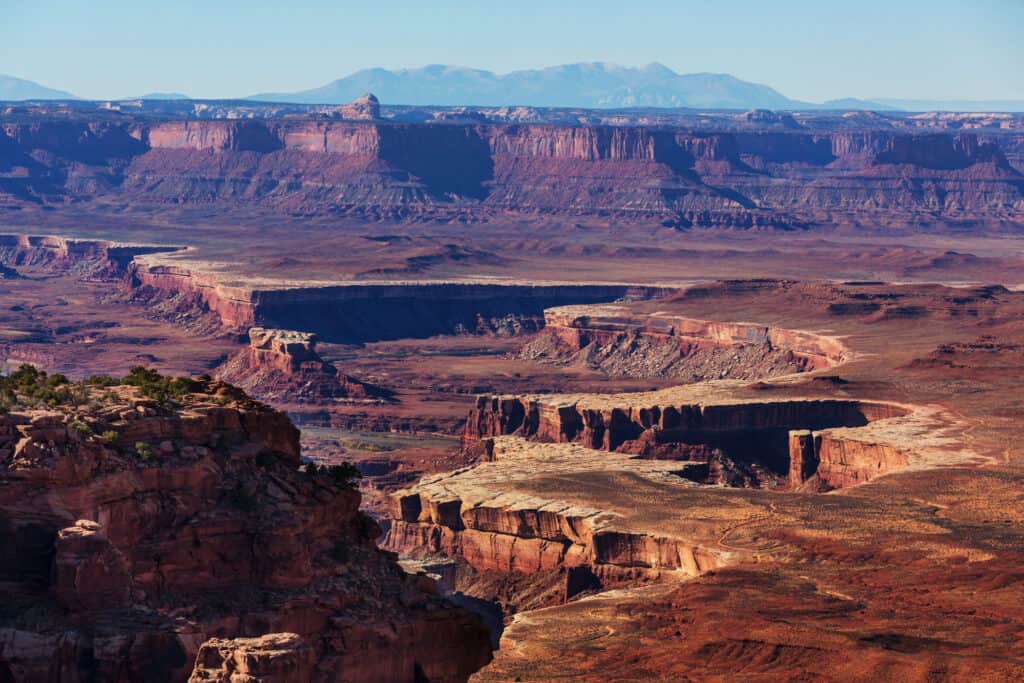
Canyonlands is a huge park and it is broken down into different districts. This itinerary is for the Island in the Sky district which is the most popular area of the park and the district closest to Moab, Utah.
You can also check out my post on the Best Things to do in Canyonlands National Park for more ideas if you have more time. I also cover off all of the tours that go to Canyonlands in my Best Moab Tours article.
Thank you for supporting this website written by an American. This post may contain affiliate links. This means I earn a small commission on these links at no extra cost to you.
National Park Entrance Fees
To enter the National Parks, you’ll need to pay an entrance fee or have a National Parks Pass also known as American the Beautiful Pass.
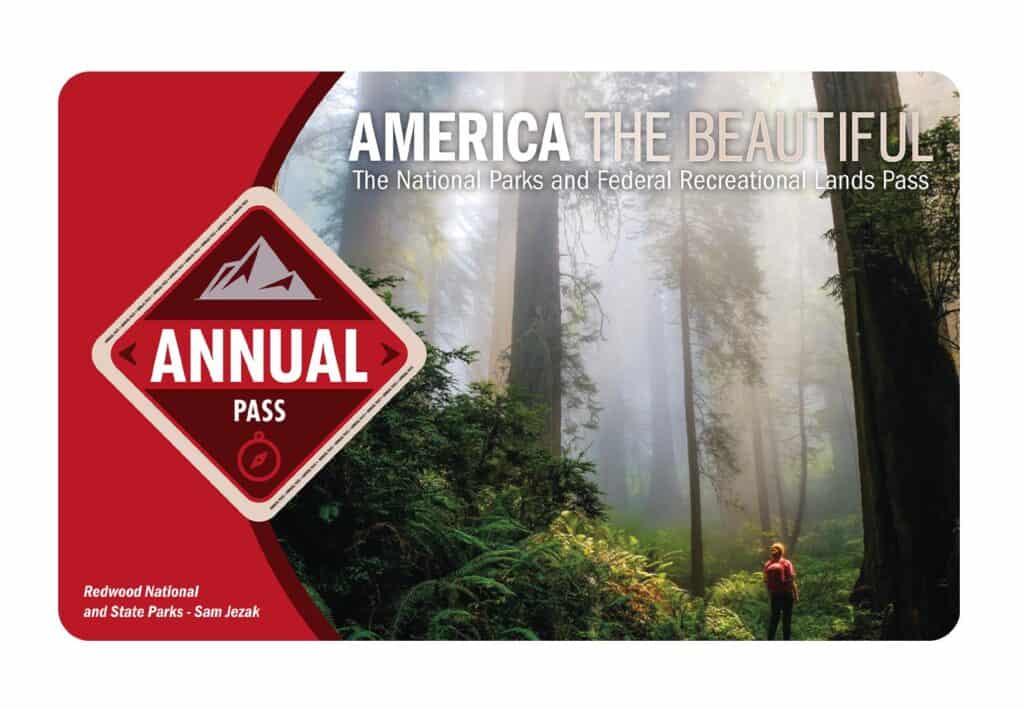
It costs $80 for a yearly America the Beautiful Pass. This gives you access to all national parks and federal areas that charge fees. The America the Beautiful Pass is well worth it!
I purchased my first one in 2016 and it’s such a money-saver! Plus 10% of sale proceeds go to the National Park Foundation.
Tips for Visiting Grand Teton National Park
Grand Canyon National Park is perfect for outdoor enthusiasts. There is something for everyone on this list and for different fitness levels. Also, note that it is dry and hot (in the summer), and make sure you know what you are getting into before you start. Here are a few tips for visiting the Grand Canyon:
- Bring a reusable water bottle and lots of water! Remember you are in the sun and you will need to drink lots of water. I love my LifeStraw Filtered Water Bottle. I can refill this bottle anywhere and it comes with a carabiner to connect it to my daypack.
- Check the Weather – days over 100 degrees are very common. Make sure to check.
- Hiking boots or sandals that will protect your feet! I love good shoes. I need all the support and help I can get. I actually love these sandals for hiking and also love these hiking boots.
- Bring hiking poles for balance and to protect your knees. I know many experienced hikers (and even amateur ones) think that hiking poles are for old people who lose their balance. Actually, hiking poles can help when going down steep inclines or when scrambling over rocks. They are great to hike with even for the most experienced hiker.
- Wear a sunhat. I feel like this whole post is about how high you are in the mountains and how much closer you are to the sun but it is so true. At elevation, you are closer to the sun and more likely to burn. Wear sun protection such as a sun hat and sunscreen.
- Be aware of the wildlife. This is the Southwest and you will need to watch out for snakes and other wildlife such as moose or a bear. Please stay away from wildlife and do not feed them. I recommend carrying bear spray as well.
- Start Early – If you want to avoid the traffic and the heat you will need to start your hike early. That way it will be nice and cool and the smog will not affect you either.
- Leave no trace. If you are new to the concept of Leave No Trace it is all about preserving the environment to ensure it is in the same or better condition when you leave it. This means that you should stick to the trails and carry out everything that you carried in. This is a great explanation of the Leave No Trace principles!
- Water shoes are great for water hikes– If you don’t have a pair, I highly suggest it as they are affordable. I have an article on the pros and cons of several pairs of water shoes.
- Bring Bug Spray and a snack: Be sure to bring everything you need including a snack like a protein bar plus BUG SPRAY.
Where to stay near Grand Canyon National Park
The Grand Canyon makes for a great weekend escape. Fresh air, beautiful scenery and being in nature does a world of good for the soul. I recommend staying as close to the park as possible and even treating yourself with a cabin with a spa pool to relax at night.
- There are lots of fantastic Airbnbs near the Grand Canyon. I have made a list of the best airbnbs around the park wherever you decide to stay. You can also check out my post on Where to Stay near the Grand Canyon to find the perfect hotel for any budget.
If you are taking a road trip remember to reserve a car in advance using Discover Cars .
National Park Entrance Fees
To enter the National Parks, you’ll need to pay an entrance fee or have a National Parks Pass also known as American the Beautiful Pass.

It costs $80 for a yearly America the Beautiful Pass. This gives you access to all national parks and federal areas that charge fees. The America the Beautiful Pass is well worth it!
I purchased my first one in 2016 and it’s such a money-saver! Plus 10% of sale proceeds go to the National Park Foundation.
Tips for Visiting Grand Teton National Park
Grand Canyon National Park is perfect for outdoor enthusiasts. There is something for everyone on this list and for different fitness levels. Also, note that it is dry and hot (in the summer), and make sure you know what you are getting into before you start. Here are a few tips for visiting the Grand Canyon:
- Bring a reusable water bottle and lots of water! Remember you are in the sun and you will need to drink lots of water. I love my LifeStraw Filtered Water Bottle. I can refill this bottle anywhere and it comes with a carabiner to connect it to my daypack.
- Check the Weather – days over 100 degrees are very common. Make sure to check.
- Hiking boots or sandals that will protect your feet! I love good shoes. I need all the support and help I can get. I actually love these sandals for hiking and also love these hiking boots.
- Bring hiking poles for balance and to protect your knees. I know many experienced hikers (and even amateur ones) think that hiking poles are for old people who lose their balance. Actually, hiking poles can help when going down steep inclines or when scrambling over rocks. They are great to hike with even for the most experienced hiker.
- Wear a sunhat. I feel like this whole post is about how high you are in the mountains and how much closer you are to the sun but it is so true. At elevation, you are closer to the sun and more likely to burn. Wear sun protection such as a sun hat and sunscreen.
- Be aware of the wildlife. This is the Southwest and you will need to watch out for snakes and other wildlife such as moose or a bear. Please stay away from wildlife and do not feed them. I recommend carrying bear spray as well.
- Start Early – If you want to avoid the traffic and the heat you will need to start your hike early. That way it will be nice and cool and the smog will not affect you either.
- Leave no trace. If you are new to the concept of Leave No Trace it is all about preserving the environment to ensure it is in the same or better condition when you leave it. This means that you should stick to the trails and carry out everything that you carried in. This is a great explanation of the Leave No Trace principles!
- Water shoes are great for water hikes– If you don’t have a pair, I highly suggest it as they are affordable. I have an article on the pros and cons of several pairs of water shoes.
- Bring Bug Spray and a snack: Be sure to bring everything you need including a snack like a protein bar plus BUG SPRAY.
Where to stay near Grand Canyon National Park
The Grand Canyon makes for a great weekend escape. Fresh air, beautiful scenery and being in nature does a world of good for the soul. I recommend staying as close to the park as possible and even treating yourself with a cabin with a spa pool to relax at night.
- There are lots of fantastic Airbnbs near the Grand Canyon. I have made a list of the best airbnbs around the park wherever you decide to stay. You can also check out my post on Where to Stay near the Grand Canyon to find the perfect hotel for any budget.
If you are taking a road trip remember to reserve a car in advance using Discover Cars .
Tips for Visiting in Canyonlands National Park
Canyonlands is perfect for outdoor enthusiasts. There is something for everyone on this list and for different fitness levels. Also, note that it is dry and hot (in the summer), and make sure you know what you are getting into before you start. Here are a few tips for visiting Canyonlands:
- Bring a reusable water bottle and lots of water! Remember you are in the sun and you will need to drink lots of water. I love my LifeStraw Filtered Water Bottle. I can refill this bottle anywhere and it comes with a carabiner to connect it to my daypack.
- Check the Weather – days over 100 degrees are very common. Make sure to check.
- Hiking boots or sandals that will protect your feet! I love good shoes. I need all the support and help I can get. I actually love these sandals for hiking and also love these hiking boots.
- Bring hiking poles for balance and to protect your knees. I know many experienced hikers (and even amateur ones) think that hiking poles are for old people who lose their balance. Actually, hiking poles can help when going down steep inclines or when scrambling over rocks. They are great to hike with even for the most experienced hiker.
- Wear a sunhat. I feel like this whole post is about how high you are in the mountains and how much closer you are to the sun but it is so true. At elevation, you are closer to the sun and more likely to burn. Wear sun protection such as a sun hat and sunscreen.
- Be aware of the wildlife. This is the Southwest and you will need to watch out for snakes and other wildlife such as moose or a bear. Please stay away from wildlife and do not feed them.
- Start Early – If you want to avoid the traffic and the heat you will need to start your hike early. That way it will be nice and cool and the smog will not affect you either.
- Leave no trace. If you are new to the concept of Leave No Trace it is all about preserving the environment to ensure it is in the same or better condition when you leave it. This means that you should stick to the trails and carry out everything that you carried in. This is a great explanation of the Leave No Trace principles!
- Water shoes are great for water hikes– If you don’t have a pair, I highly suggest it as they are affordable. I have an article on the pros and cons of several pairs of water shoes.
- Bring Bug Spray and a snack: Be sure to bring everything you need including a snack like a protein bar plus BUG SPRAY.
15 Incredible Things to do in Canyonlands in a Day – Island in the Sky District
Visitor Center Viewpoint
A view comparable to that seen from Shafer Canyon Viewpoint stretches out in front of you, however, it appears to be more stunning here for some reason. The valleys, mesas, dirt roads, and the distant La Sal Mountains combine to produce a breathtaking scene.
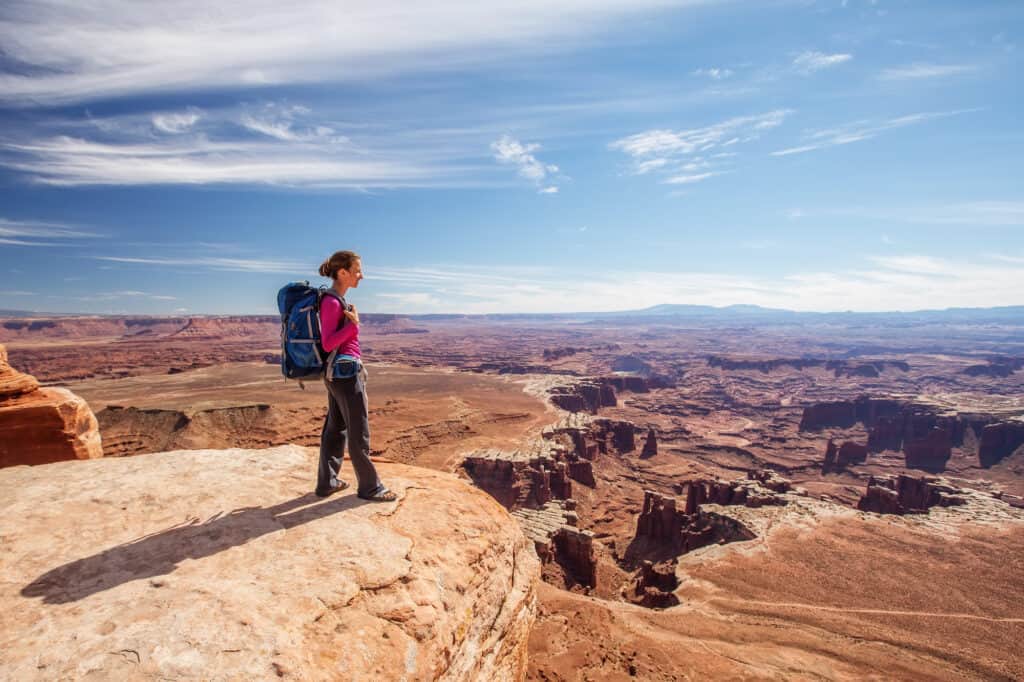
As you enter the park, you’ll find the visitor center, which includes maps, brochures, and public restrooms. The most striking characteristic of the tourist center is that it is located just across the street from a breathtaking view.
Park at the Visitor Center, cross the street and walk out to the final viewpoint before leaving the park. You’ll be glad you took the time to do so. Hours vary according to each season. Among the amenities provided are exhibits, book and map sales, backcountry permits, picnic spots, general information, wireless internet, and park rangers on duty. A video describing the park is also available. The visitor center has water available all year.
It takes 45 minutes to return to Moab from here.
Mesa Arch – the best hike and view in Canyonlands
Mesa Arch is one of Canyonlands’ most popular attractions. A midday visit here can be uncomfortable due to its popularity and the lack of a parking lot. And if you arrive at or shortly after daybreak, you will be able to see the arch at its best.
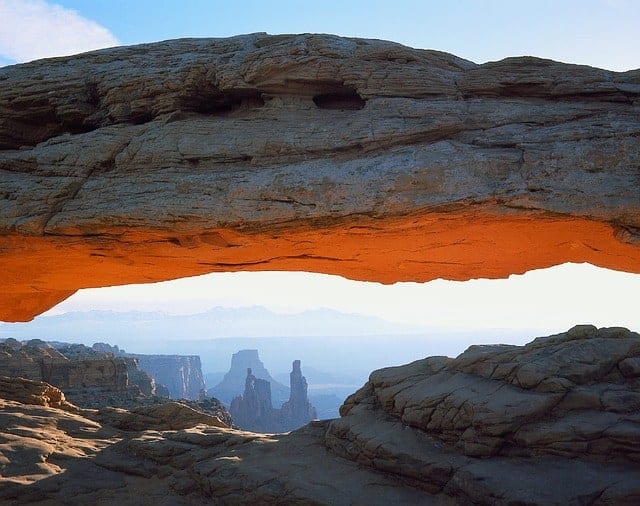
Mesa Arch and the scenery below and in front of it are illuminated by the sun in the early morning light, making it a photographer’s dream. As a result, Mesa Arch and its parking lot can become extremely crowded, with hundreds of people attempting to capture the perfect sight of the sun rising through the arch. Visit within an hour or two of sunrise to escape some of the crowds, when the light is still low enough to cast a lovely morning glow.
You’ll have to travel 0.5 miles round trip to get to Mesa Arch. The entire visit takes 30 minutes, but if you arrive early to capture the sunrise, it may take a bit longer. It’s a 10-minute drive from the Visitor Center to get here.
Return to the trailhead via the loop after leaving the arch for a 0.7-mile hike with 75 feet of elevation gain. On your way back, you’ll get a great view of the Aztec Butte rising above the mesa beyond the parking lot.
Island in the Sky
The Island in the Sky mesa rises 1,000 feet (304 meters) above the surrounding area on sheer sandstone cliffs. Every overlook provides a unique perspective on Canyonlands’ breathtaking scenery. The simplest section of Canyonlands to explore in a short amount of time is Island in the Sky, which has many pullouts with amazing views along the paved scenic route. Hiking routes and four-wheel-drive roads can transport you into the backcountry for a few hours or several days.

Drive US 191 10 miles (16 kilometers) north of Moab or 22 miles (35 kilometers) south of I-70 to reach Island in the Sky. Turn left onto UT 313 and drive 22 miles southwest (35 km). It takes roughly 40 minutes to drive from Moab to the visitor center.
Canyonlands’ Island in the Sky section is the most accessible. In addition, it is close to Moab and Arches National Park. If you just have a short amount of time, this location is ideal for driving tours and short walks. Some of the park’s most popular sights are accessible via the beautiful road.
Shafer Canyon Overlook
The Shafer Trail Viewpoint, small parking space on the side of the road, is the first overlook. This gives you a close-up perspective of Shafer Point Road’s switchbacks. It’s not a big deal if this parking lot is filled. The Shafer Canyon Viewpoint is the next turnoff. This parking lot is significantly larger, and the view of Shafer Trail Road is similar.

Shafer Canyon may be seen from the Shafer Canyon Overlook. You may walk out to the edge of the mesa, which is 1,400 feet above the canyon, and stand there. The Neck Spring trailhead is also located in the parking lot. Shafer Trail, which leads to White Rim Road, and the mesa where Dead Horse Point State Park is located may both be seen from the edge. In the distance, you can see the La Sal Mountains.
It’s only a short distance to the big plateau. The views from here are spectacular, including vistas across the White Rim and Dead Horse Point State Park off in the distance (a state park that is well worth the visit and just as stunning as Canyonlands).
Return to the Visitor Center by turning left onto Grand View Point Road. There are two viewpoints just before you reach the Visitor Center.
Green River Overlook
The Green River Overlook is located at the end of the paved road just past the Willows Campground in Canyonlands National Park’s Island in the Sky District. At about 6,000 feet, the vantage point offers a spectacular perspective of the canyon, which is unique to the Island District due to its canyon geology. The huge Soda Springs Basin is home to the Green River, which winds its way through it. The White Rim Trail is also visible from afar.

Because of its accessibility and expansive view, this is a must-do when visiting the Islands in the Sky District. For the best experience and lighting, come one hour after sunrise or sunset. This allows the sun to streak above the rolling hills of the canyon, generating lovely highlights and shadows.
The best time to shoot the Green River is late afternoon or close to dusk, when the late sun illuminates the canyon’s west-facing cliffs. Reflected light, according to many photographers, enriches the Colorado Plateau by bringing out the soft reds of the canyons.
Don’t miss out on this spectacular view! The panorama from this vantage point is breathtaking, spanning hundreds of kilometres. The Green River may be seen flashing through the canyon in a few sparkling slivers.
White Rim Overlook
The White Rim Overlook hike is 1.8 miles round trip and takes about one hour. It’s completely flat and provides views comparable to those seen on the climb from Grand View Point. This trail, on the other hand, is significantly less crowded and was one of Canyonlands’ unexpected discoveries.
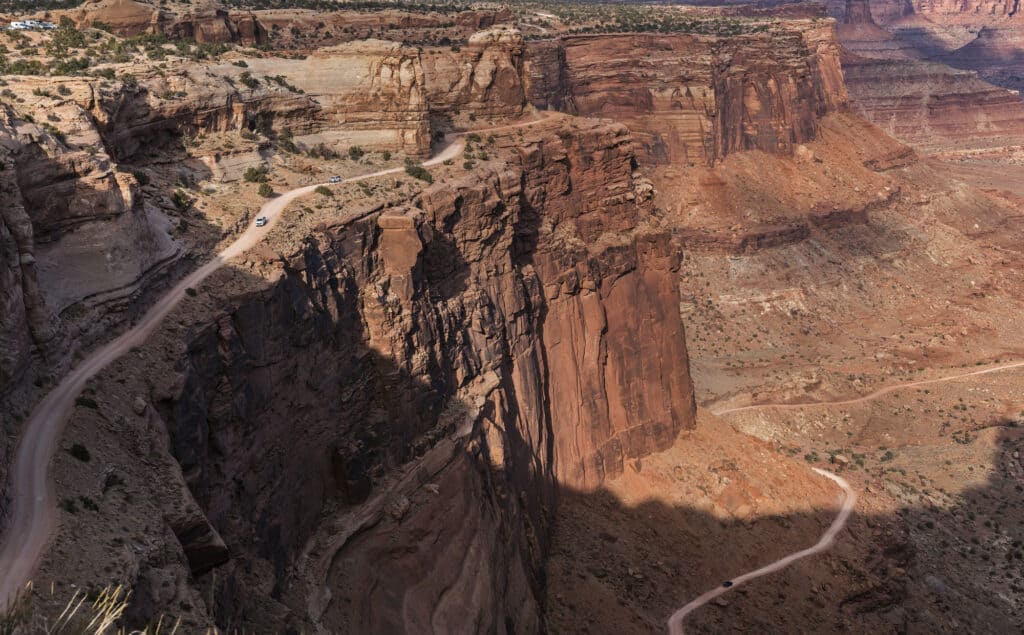
Once you’ve found a parking spot, start hiking down some Slickrock away from the picnic area. Soon after, the trail splits, with the Gooseberry Trail going left and falling precipitously into the canyon, and the White Rim Trail going right. Keep going in the right direction.
The White Rim Trail softly descends as it travels out onto the ever-narrowing peninsula. The trail alternates between easy-to-follow singletrack and Slickrock sections marked by cairns. Continue east until you’ve seen everything the peninsula has to offer. Awe-inspiring sights can be found here. There will be vistas of the Colorado River, the popular 4WD White Rim Road, Monument Basin, and the La Sal Mountains.
Proceed with caution because there are massive dropoffs all around the viewpoint area. Once you’ve taken your fill of shots and taken in the view, return the way you came to the trailhead.
With minimal effort, the climb to White Rim Overlook in Canyonlands National Park’s “Island in the Sky” section provides stunning views. The most challenging part of this hike may be finding a parking spot, as parking at the trailhead is limited. However, this helps to keep crowds off the trail, so you’ll likely only see a few people on your hike.
Grand View Point
The Canyonlands area may be seen from Grand View Point, which has a fantastic view. From the viewpoint at 6,080 feet elevation, you can see distant mountains, canyons, basins, and the White Rim Road.

To get to the first viewpoint, go 100 yard trail from the parking lot on a paved trail. This trail is suitable for people in wheelchairs. Rangers frequently offer geology talks at the viewpoint, and there are outdoor exhibits that describe the vista.
While you’re here, you may either relax and take in the scenery or go for a hike on the Grand View Point Hike. This hike is 2 miles round trip and takes around 1.5 hours to complete. If you merely want to see the vista, a trip here will only take you around 15 minutes.
This is definitely worth a stop and one of the best locations to begin if you only have a half day in Canyonlands National Park.
Upheaval Dome
Scientists are baffled by Upheaval Dome, which is strange, colorful, and fascinating. This odd rock depression in the ground is rather wide and cool, with red and white streaks running through it. Upheaval Dome is a massive crater that was most likely produced by a meteorite, however other explanations exist. This is an unusual place to see in Canyonlands because it looks nothing like the canyons seen from the overlooks.
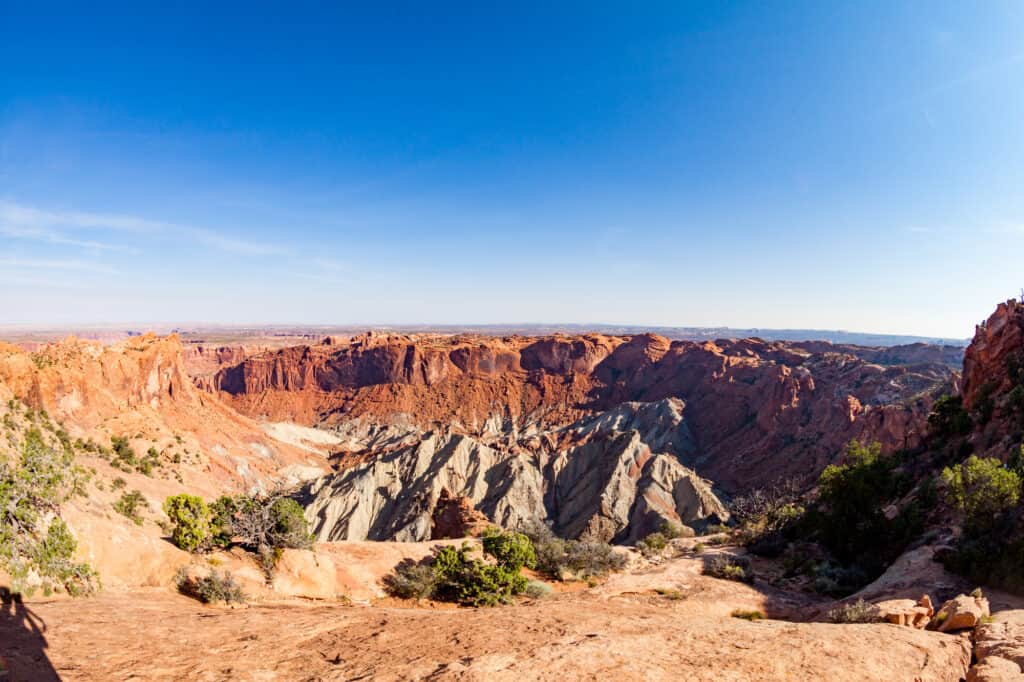
You’ll have to hike a bit to get to the vistas. On well-marked trails, it’s an easy to moderate hike. There are two viewpoints from which to view the Upheaval Dome. To get to the first overlook, you’ll have to hike for about 0.4 mile up a short but steep trail (one-way).
Upheaval Dome is a strong contender for the greatest hikes in Canyonlands National Park! The hike is 1.8 kilometers round trip and takes between 1 and 1.5 hours to complete
To get to the trailhead, drive south approximately 6.5 miles from the Island in the Sky Visitor Center. Turn right onto Upheaval Dome Road after reaching the Mesa Arch turnoff. To get to the end of the road, drive 5 miles. There are restrooms and picnic tables near the trailhead.
Candlestick Tower Overlook
Candlestick Tower is a 450-foot tall sandstone butte in Canyonlands National Park’s Island in the Sky District in San Juan County, Utah. It gets its name from the fact that it looks like a candlestick.
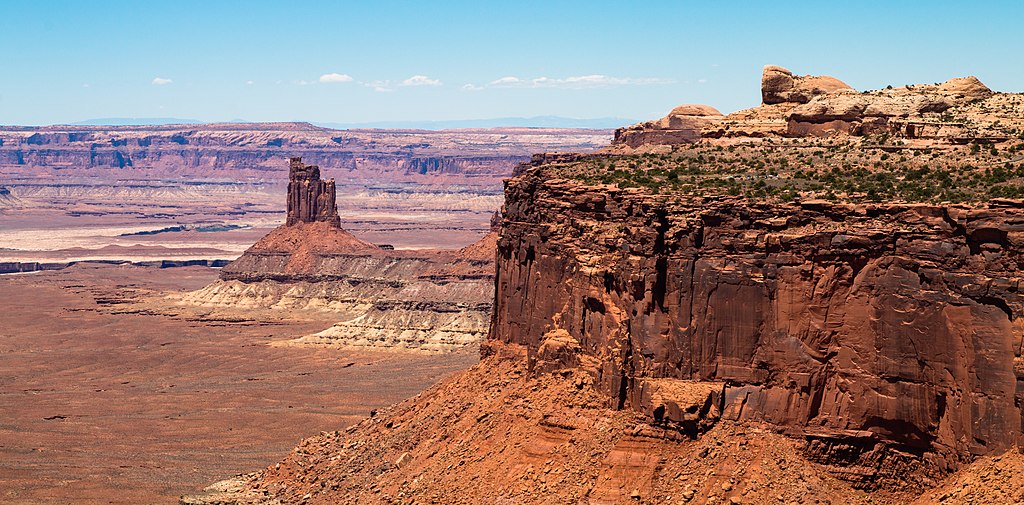
Wingate Sandstone, which was formed by wind-borne sand dunes 200 million years ago in the Late Triassic, is used to construct Candlestick Tower. Shaft Benchmark is 3.2 kilometers to the east, Upheaval Dome is 4.8 kilometers to the north, and the Green River Overlook is 4.0 kilometers to the east.
The White Rim Road, which requires four-wheel drive, leads to the tower. Candlestick is a geological feature that rises 1,400 feet above the White Rim Road in about one mile, north of Soda Springs Basin and south of Holeman Spring Basin. These two basins drain precipitation runoff from Candlestick Tower into the nearby Green River.
The views of Canyonland including this notable feature that resembles a bunch of candlesticks, may be seen from this small roadside pullout. From your vehicle or along the paved pullout, you can see the Candlestick Tower. Closer to the canyon rim, the terrain is unpaved, rocky, and uneven. There is also scarcity of parking. At any given time, the paved roadside pullout can accommodate 4-5 cars.
Aztec Butte
Aztec Butte Trail is a great alternative for people looking for a moderate morning hike that will give them a decent workout and provide them with unique scenery. Returning to Upheaval Dome Road, turning left, and stopping at the trailhead (there’s a small pullout with a few parking spots) will get you to the trailhead.
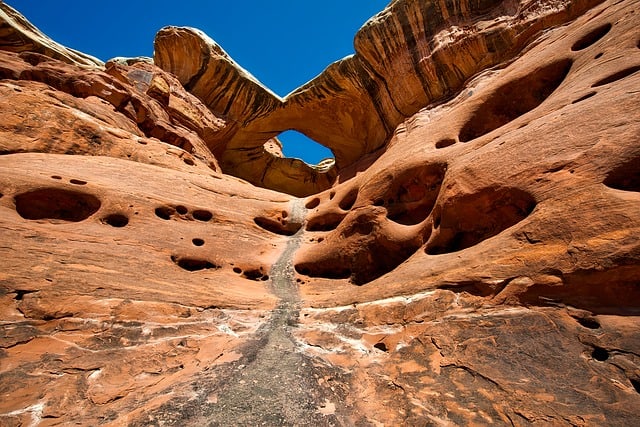
Located in Canyonlands National Park’s Island in the Sky section, Aztec Butte is a one-of-a-kind hike. Before ascending a steep incline to a dome-shaped butte that rises above the mesa, the trail passes through flat meadows. The early inhabitants used alcoves and the butte’s rim to house Puebloan granaries for storage.
This hike is breathtaking, but it is not for the faint-hearted. The track is well-defined and on packed sand for the first two-thirds, but near the end, you’ll trek 200 feet up a tough Slickrock slope, following cairns. Since there are no handrails, climbing up the slick rock slope to the top of the butte is more challenging than climbing Whale Rock. Make sure you’re properly attired.
On the upper butte, there are several one- and two-room granaries, and two more on the lower butte. There should be no touching or entering of these structures. There are also some breathtaking views, particularly of the massive Trail Canyon headwall to the northwest. You may go up and around the peak of a comparable butte between Aztec Butte and the trailhead. Keep an eye out for a trail that forks off to the west just before you begin going around the other butte if you take this route.
Buck Canyon Overlook
Buck Canyon Overlook is located just off Grand View Point Road in Canyonlands National Park’s Island in the Sky section. Buck Canyon is less visited than some of the other attractions in the area, although it is far from deserted.
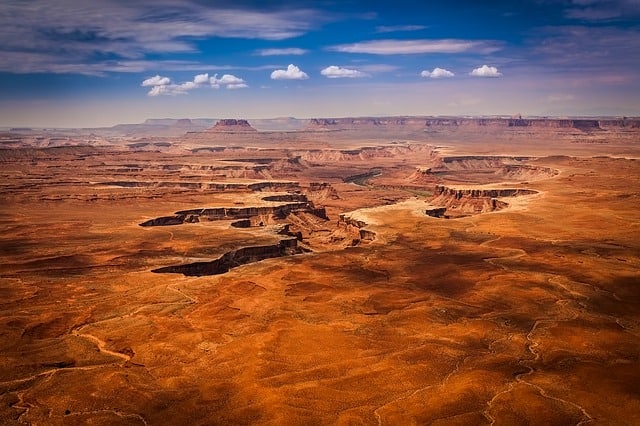
The viewpoint is only a short distance from the parking lot, which is accessible through a paved walkway. Down into Buck Canyon, there are some breathtaking vistas. The La Sal Mountains rise out of the red canyon rock, and the Colorado River and the popular 4WD White Rim Road may be seen in the distance.
Down in the canyon, you might be able to make out the faint outlines of some more roads and seismic lines. These were built in the 1950s as part of a uranium and oil search. Despite the fact that these mining operations have been suspended for a long time, their effects may still be seen. Natural revegetation is progressively mending these issues, however in this arid climate, it will take a long time.
Stay for Stargazing
Last but not least, if you have the inclination and time, I recommend staying in Canyonlands to stargaze. In Canyonlands, there are a number of excellent spots for stargazing, but you may also stay at Grand View Point and gaze at the night sky from there.
Another alternative is to return to Dead Horse Point State Area after exiting the park. This is one of the best places in Utah to go stargazing, and they have regular astronomy sessions during the summer.
The Needles
With its vast collection of red and orange sandstone spires, this section of Canyonlands National Park looks significantly different from the Island in the Sky district. If you enjoy hiking, backpacking, or seeing new places, The Needles should be on your bucket list. This section of the park can be explored in one day.
The Needles is an area of Canyonlands National Park that is frequently overlooked. Those who make the trip to the Needles, however, are rewarded with thrilling, unique hiking trails, minimal crowds, and breathtaking views of Canyonlands National Park.
The Needles district, unlike anywhere else in Utah, has a strikingly different appearance. The Needles’ heart is made up of clusters of zebra-striped sandstone spires that resemble Bryce Canyon’s hoodoos. Hiking pathways thread their way amongst the needles, making this, in my opinion, the best hiking site in Canyonlands.
The Needles area is a small one. The main route through the park is less than 7 miles long and takes less than 10 minutes to travel through. Off of this major, paved road, however, there are dirt and gravel lanes. Some of these dirt roads may be driven in regular cars, while others require a 4×4 and/or a permit. The Needles are a 75-mile trip from Moab that takes around an hour and a half. Most individuals are put off by the distance and time required to travel this route.
The Maze
The Maze is Canyonlands National Park’s most remote and secluded section. Because of the distant location, difficult roads, and rustic paths, exploring here necessitates a higher level of self-sufficiency.
Travel to the Maze takes longer due to the district’s isolation and the difficulty of the roads and trails. Visitors must be self-sufficient and have the necessary equipment or gear to self-rescue. The Maze is rarely explored for less than three days, and the area can easily accommodate a week-long adventure
The Maze Canyons are another 3 to 6 hours by high-clearance, 4WD vehicle from the ranger station (more if traveling by foot). From Highway 95 near Hite Marina, another four-wheel-drive route continues north into the Maze (driving time is 3+ hours to the park boundary).
The Glen Canyon National Recreation Area’s Orange Cliffs Unit shares Canyonlands’ western boundary and is managed under the same backcountry management plan and permit/reservation system as Canyonlands. While certain regulations differ, the information provided here should help visitors plan trips to Orange Cliffs.
Prepare for self-rescue by stocking up on supplies, water, and gear. The Maze will grant your request if you truly want to escape away from it all. Make thorough preparations for your visit. The Maze District is open year-round, 24 hours a day.
Dead Horse Point
The mesa at Dead Horse Point is long and narrow. The “neck” is the narrowest point on the mesa, and beyond it is a final outcropping of land with drop offs on all three sides.
Cowboys allegedly corralled wild mustangs on the mesa’s tip and then fenced off the neck with branches and brush, according to legend. The cowboys chose the best mustangs and abandoned the rest of the horses on the point, without water, to die.
A small parking space for this viewpoint is located at the end of the park’s road. From here, you may gaze out over a breathtaking landscape of buttes and mesas. The mighty Colorado River winds its way through the canyon 2000 feet below the overlook. From the overlook, the best view is to the southwest. The Colorado River’s gooseneck may be seen from here, with Canyonlands National Park in the distance.
Canyonlands National Park is located east of Dead Horse Point State Park. Moab, Utah is the closest city. It takes 45 minutes to drive from Moab to get here (33 miles). Turn left onto UT-313 off US-191 and proceed until you reach Dead Horse Point. For instance, it would take 20 minutes to drive from the Dead Horse Point Visitor Center to the Canyonlands Island in the Sky Visitor Center (14 miles).
Where to Stay near Canyonlands National Park
I have an entire post on the best places to stay near Canyonlands. I even go through where to stay if you are visiting different districts of Canyonlands. Or you can check out my post on the Best Airbnbs in Moab, Utah for vacation rentals.
If you are looking for a place to stay in Moab, I recommend the following:
Castle Valley Inn
Castle Valley Inn offers a family-friendly environment hotel for travelers who are visiting Moab. It is perfectly situated in the heart of the American west, and a spectacular scenic drive just 16 miles outside of Moab. And did you know that Castle Valley Inn is well-known for its home-away-from-home hospitality and delicious breakfast? Plus, they share their popular dishes on their website, you should definitely check it out.
The rooms at Castle Valley Inn are also exceptional and you will be able to experience tranquility at their 5-acre oasis. The guests rooms feature free internet access and wi-fi, air conditioning and fans, a DVD player and monitor, coffee and tea, refrigerators, hairdryer, and luxurious bathrobes.
And inside the property, you can also enjoy the following amenities: a hot tub located at the end of the garden, homemade treats every afternoon, organic coffee from their local roaster, hammocks hidden underneath tall trees, BBQ grills for all the guests suites, and a lot
CHECK AVAILABILITY ON BOOKING.COM
MainStay Suites Moab
If you are looking for a long or short term accommodation in Moab, MainStay Suites is a great choice. It offers an apartment-style living with all the benefits of a hotel stay. It is conveniently located on Moab’s Main Street, thus giving you easy access to a lot of local sites and attractions in Moab.

Their spacious and homey guest rooms offer basic kitchen facilities, luxurious bedding, USB ports for easy charging, a flat screen TV, and a coffee maker. You can also take advantage of the hotel’s amenities such as a business center with copy and fax services, on-site convenience store, fitness center, guest laundry facilities, and more.
CHECK AVAILABILITY ON BOOKING.COM
Recent Posts
15 Tips for Visiting the Grand Canyon in September – 2023 Ultimate Guide
Visiting the Grand Canyon in September is a great time to visit. September is a busy time to visit but the crowds are starting to arrive especially toward the end of the month. I’ve included...
15 Tips for Visiting the Grand Canyon in August – 2023 Ultimate Guide
Visiting the Grand Canyon in August is a great time to visit. August is a busy time to visit but the crowds are starting to arrive especially toward the end of the month. I’ve included all...
